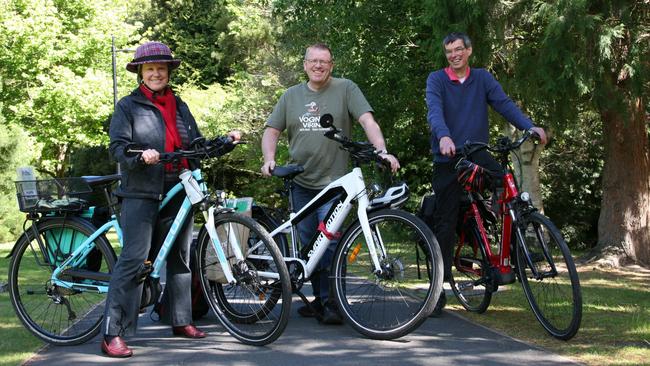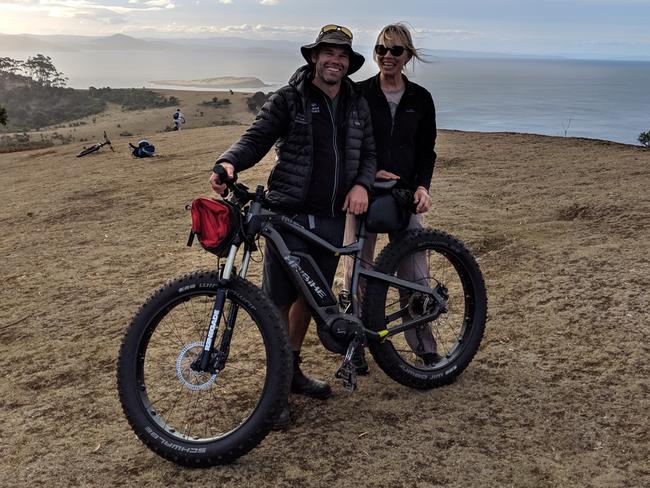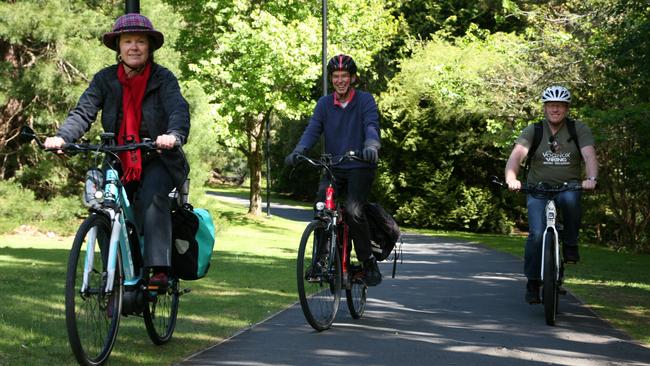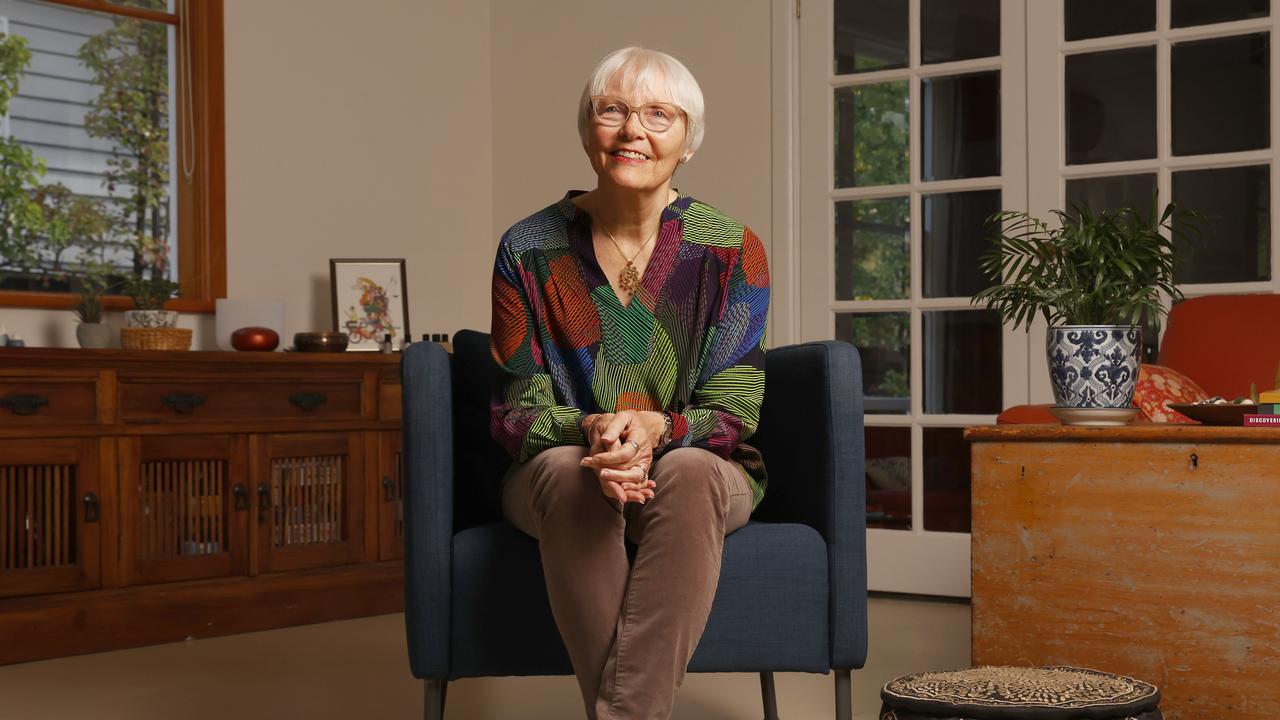TasWeekend: E-bike revolution rolls on amid dedicated bike lane shortage
Electric commuter bikes are shaping up as an eco-friendly solution to traffic woes and carbon emissions – and they are also great fun.

Picture: AMANDA DUCKER
Lifestyle
Don't miss out on the headlines from Lifestyle. Followed categories will be added to My News.
AFTER my first e-bike ride there is no turning back. It’s on Maria Island in late autumn that I’m ruined for conventional riding. Covering a lot of ground fast, I am hooked before we reach the Painted Cliffs south of the former convict settlement at Darlington.
Returning to the East Coast island months later, I feel no desire to join the pedal pushers puffing their way up the hills under their own steam.
Observing their shrinking silhouettes huddled over the handlebars from the veranda of the Penitentiary, I envision a future Hobart spinning with e-bikes. And I am soon to discover that it’s mostly the deadly lack of dedicated cycleways holding us back.
Back in Hobart after the latest Maria jaunt, I ask tourism operator Ben Rea, who runs Tasmanian E-Bike Adventures, what he thinks. It’s Rea who introduced me to pedal-assisted mountain bikes on a guided day tour of Maria in April, when I spent hours in the saddle of one of his German Haibike fleet, riding with a handful of other guests.
He says Hobart’s topography and lifestyle make it an ideal place to encourage e-bikes as an active transport commuter mode.
“E-bikes are a huge part of the solution to sustainable transport,” he says. “They are enabling for older people — it brings out a playful young person in them — and they are a positive part of the picture now.
“But in Hobart it will rely on people becoming safer. We need designated carriageways for bicycles and bike lanes so people don’t feel intimidated. We need planning around a transport network that actively encourages people to get on bikes.
“It doesn’t matter if you are on an e-bike or [a conventional] bike, incremental change can only be led by creating the space for people to occupy.
“There’s some fantastic people at Hobart City Council doing that research, but it comes down to resourcing it. Only by planning it and leading it are we going to get people out of cars.
“It’s a cultural thing, the car, and we need to get people addicted to e-bikes.”

As well as his Maria offering, Rea runs private e-bike tours of Bangor near Dunalley – and guests bring e-bike news from afar.
“I had a woman from Monaco on one of my trips a few weeks ago, and she was saying it’s now a real part of the public transport system there and you can pick one up anywhere,” he says.
In the mountainous terrain of the tiny European principality, Prince Albert recently launched MonaBike, a new electric bike-share system, with 300 new bikes and 35 smart-charging stations part of its small-city strategy.
Europe is a leader in both technology and take-up. In Germany one in four bicycles sold is an e-bike, with sales soaring by 37 per cent in the first half of 2019. In Belgium, e-bike purchases attract tax incentives. And in Sweden, you can get a subsidy of up to 1000 euros when you buy one, industry figures show.
Mountain biking is big news in Tasmanian tourism, and Rea says e-biking is quietly playing a part at the Derby hub, too, with numerous operators now using e-bikes as shuttles. They are also becoming a training tool for world Enduro riders, says Rea, enabling riders to finesse manoeuvres at high speed.

The University of Tasmania may become the first local employer to offer staff the option of leasing an e-bike, a parliamentary inquiry into greater Hobart’s traffic congestion has heard.
UTAS Southern Futures executive director Tim Rutherford two weeks ago told a Legislative Council select committee the university was negotiating with a provider to offer e-bike leasing via salary sacrificing, ahead of the university’s relocation to the CBD. Mr Rutherford said both user and employer benefited as no fringe benefit tax was payable on e-bikes, unlike cars.
For purchasers, there’s good news, too. As brands compete in the growing market, e-bike prices have fallen in the past few years, putting them in reach of many more Tasmanians.
That’s not to say they are cheap, a standard new bike typically costing $2000 or more. They are cheap to run, though, with the batteries powering the integrated electric motor lasting 50km–80km and costing 10c–15c to charge.
Teros in Elizabeth St, Midtown, is one of the local retailers that will be offering test rides at tomorrow’s E-bike Expo at the Regatta Grounds. Owner Ahmet Bektas says his team did 150 test rides at last year’s event, with sales of its range of battery-powered pedal-assist cycles growing 25 per cent annually.
“Over the past four years, our sales have doubled,” says Bektas. “And in the past year we have seen a big trend of young families ditching second cars to get cargo e-bikes for commuting, school drop-offs and pick-ups and shopping.”
It is mostly older Tasmanians who blazed the trail in the state. Di Elliffe is Bicycle Network Tasmania’s social rides co-ordinator and a cyclist from way back, but she was out of the saddle for decades before buying her first e-bike 10 years ago.
“It made it a lot easier to get back on and back in the swing of it,” says the West Hobart resident.
“The hills in Hobart are a big barrier for a lot of people who just don’t feel strong enough, and the electric-assist kicks in when you want it, and to the extent you want it, so you can glide up hills.”
As active commuter transport, Elliffe says the bikes are marvellous.
“It’s much faster than walking, faster than a normal bike and with the convenience of parking, faster than a car as well.”

We meet at Hamlet Cafe on the Hobart Rivulet, just off Molle St, before riding up the rivulet track to Cascade Brewery with a few other e-bike aficionados.
Elliffe takes her bike out daily for meetings and other outings, throwing on her colourful hat helmet and ensuring she has a strong lock with her, as e-bikes are a theft risk.
The biggest risk though is not theft — it’s road-riding without dedicated cycleways.
“We are advocating for a minimum grid of protected bikeways,” says Elliffe. “Riders coming off the rivulet path at Molle St would connect to a protected path along Collins St, then through carefully selected commuter and feeder routes to connect to the inner-city cycleway to head up towards North Hobart.”
A protected bikeway is either separated by a kerb, bollards or walls. Elliffe says bikeways in the Hobart CBD would ideally run alongside the pavement, currently dominated by kerbside carparking.
“Half the streetscape is dedicated to carparking,” she says. “We need to access some of that space. Take out the carparking down one side.”
She says the City of Hobart needs support from other levels of government “to shift the culture and change the debate”.
Children’s book illustrator and e-cyclist Tony Flowers arrives at Hamlet with his art materials hanging in a hessian bag off the side of his bike. He has had an e-bike for three years, buying it during a stint living in Canberra, where dedicated cycleways are numerous. He is disappointed by the lack of progress in making space for them in Hobart.
On the bright side, he has noticed less dissing when he’s on his e-bike. “I’ve been back in Hobart for two years, and it used to be that when you were riding around people said you were cheating. Now everyone stops and asks you about them. And I notice that the number of e-bikes now using that commute down through Salamanca from the old railway line [from the northern suburbs] is just enormous. That rail corridor is fantastic. It’s like a little slice of Canberra here in Hobart.”
Jack Gilding of the Tasmanian Renewable Energy Alliance is another keen cyclist who is a convert to e-bikes — not just for commuting and recreational riding, but as a valuable piece of a sustainable transport system. He is also one of several Bicycle Network of Tasmania volunteers who takes e-bike newbies out for test rides like mine today along the Hobart Rivulet.
He says that while Tasmania is well-positioned to become a zero carbon-emitting electricity generator in the next decade, mostly on the back of the state’s established hydro resources, carbon pollution from transport remains a huge challenge.
Energy security is another concern.
“The huge amount of money Tasmania spends on importing fossil fuels is an issue in terms of carbon emissions but also energy security,” says Gilding.
“If we had electric bikes, buses and cars we would not be as vulnerable [to liquid fuel imports]. At the moment we are incredibly vulnerable. Tasmania is at the end of the supply chain.”
It’s far easier to run out of battery power on an e-bike atop kunanyi/Mt Wellington, which is what happened to Gilding on a recent ride.
“Starting with a full battery, I did just get to top,” he says. “It went flat, but of course it didn’t matter on the downhill ride.”
Bicycle Network Tasmania is hosting a free E-Bike Expo tomorrow from 10am to 2pm at The Regatta Grounds, on the grassy area between McVilly Drive and the Cenotaph, Hobart. For more information, visit biketas.org.au


